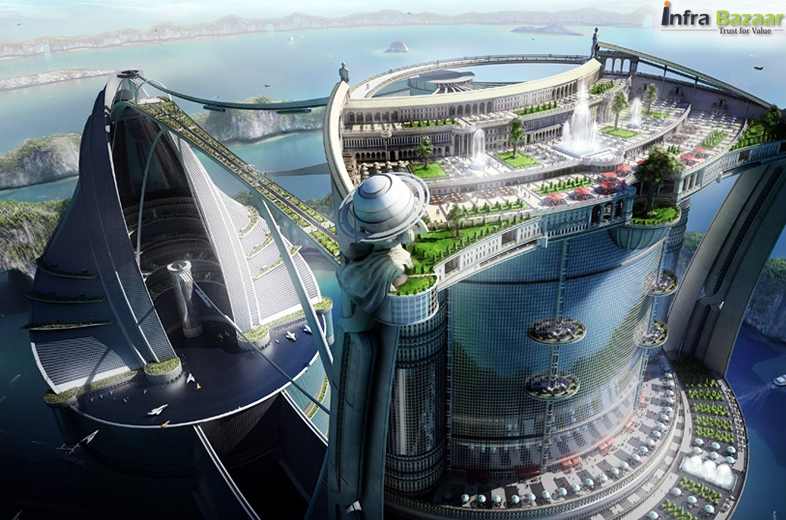
Posted By:Infra Bazaar
Today there is a stress on indestructible molecular building blocks, self-cleaning glass surfaces, and the future of building materials is undergoing a revolutionary change. There is a great deal of research to develop the Building Materials today, which have the potential to alter the shape of Architecture. Staying abreast of the latest technology and resources is a necessary trait in order to develop the products which can stay steady to the demands of the future and meet the specifications.
Unbreakable Materials
There is a use of two-photon lithography to create precise polymer nano-trusses that can be coated with metal or ceramic materials and hollowed out to remove the polymer and then put to effective use in a fractal construction. It couples the structural and material properties of its medium, to possess the characteristics including flaw-tolerance and shape memory. it can be used in the built space like battery cells, smart windows, heat exchangers, and wind turbines. A paper that cannot get wet and a non –tearing thermal insulation can be made here.
Resilient finishes
A new coating resists moisture even after being scratched or exposed to oil for application to glass, steel, paper, and other materials, is being prepared. It is made from coated titanium dioxide nanoparticles; the finish rejects the invasive substances off its surface and removes dirt in the process. It can be used in automobile paint and moisture-resistant coatings. It could be used to create a durable, self-cleaning façade that can withstand the elements.
Wave Benders
Researchers have developed a new way to control elastic waves which travel through materials and do not change their composition thus protecting structures from the impact of seismic events. There is a geometric microstructure pattern to bend or refract elastic and acoustic waves away from a target. the shock waves carrying massive energy around the important infrastructures or residential buildings are redirected through a material cloak, through which civilian lives and common properties can be saved from catastrophic earthquakes or other natural disasters. It is greatly functional.
Better Graphene
A new and faster way has been found to produce graphene in a mass manner. a high-quality processing method allows for the growth of smooth and strong graphene sheets which cuts production time drastically and increases sample sizes from millimetres to inches. The process is process-compatible, and can be effectively used in architecture are in small-scale products such as coatings, solar cells, and electronics. It is a one-atom-thick layer of carbon, transparent, thin, strong, and flexible, and also conducts electricity. it can be used in solar cells, touch screens, aerospace materials, desalination technology, and transistors.
Stronger Concrete
Cellulose nanocrystals from wood fibre are being added to concrete. Nano-reinforced materials deliver a strong performance compared to conventional alternatives across a range of mechanical and chemical properties. They have better strength, impact resistance, and flexibility. They reduce the environmental footprint of a structure by needing less material to achieve a similar effect. The additive can be extracted as a byproduct of industrial agriculture, bio-energy, and paper production. It enhances the concrete-curing process also. It allows the concrete to use water efficiently and without impacting its weight or density. The process to assess data to standardize and optimize the material’s behaviour is in progress.
These futuristic building materials will change the way of construction of buildings tomorrow.
Super waterproof material
Another development is the super waterproof material. It can withstand extreme changes in temperature, pressure, and humidity. The water bounces off, carrying dirt and becomes antibacterial. It is a smart move in the coating for boat hulls, medical devices, windshields, and steam turbine generators.
Aero-graphite
It is made from hollow carbon tubes, conducts electricity and is strong but bendable. It can be compressed and returned to its normal size while becoming strong. it has the ability to withstand a lot of vibration and is ideal to be used to make lighter batteries, air and water purification systems, aviation materials, and satellites.
Protective material
A material made up of rubber and glassy layers come with the strength to stop a bullet. When the material is struck, it liquefies to disperse the energy and then hardens to close the entryway. It can be an ideal ballistic windshield material.
Lightweight material stronger than steel
A material that is less dense than water and as strong as some forms of steel is also being developed today.
With such unique materials, the future presents exciting possibilities and can develop much more depending on the demands and requirements.
For procurement of high qulity construction equipment please visit our website http://www.infrabazaar.com or Flow our Facebook page business.facebook.com.
#BuildingMaterials #RevolutionaryInnovations #Unbreakable #Resilient #Graphene #Concrete #Waterproof #Lightweight #Protective #FutureOfConstruction